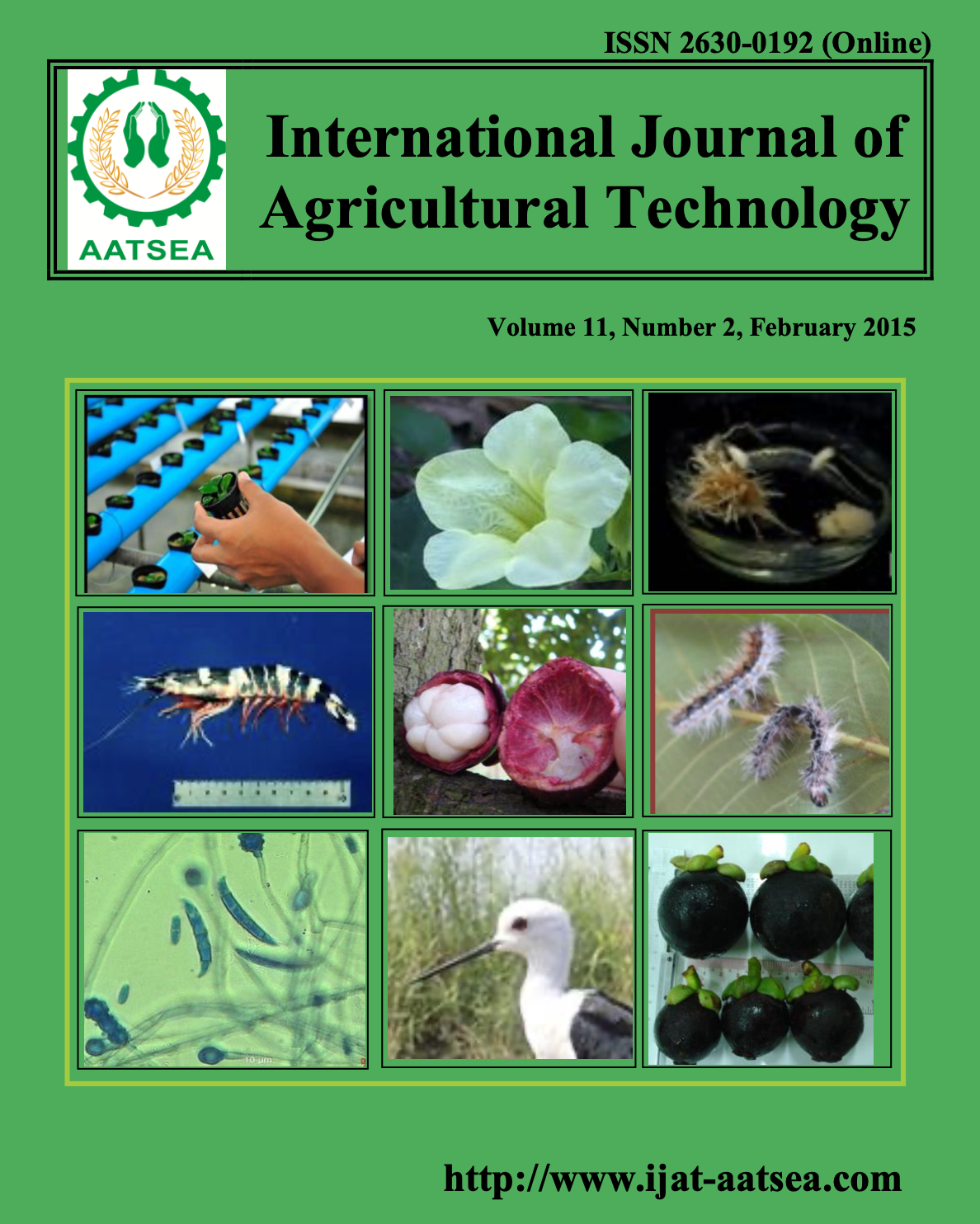Bag opening technique for bag spawn culture of spit gill mushroom (Schizophyllum commune)
Main Article Content
Abstract
Schizophyllum commune (spit gill mushroom), the wood decay is the most beneficial mushroom. It has been known as the medicinal mushroom. It contains high essential medicinal compound, anti-oxidant, anti-cancer polysaccharide and producing anti-bacterial secondary metabolites. Bag opening technique was conducing to enhance produce of bag spawn mushroom culture by using sawdust as culture medium. Vertical cutting, 45 degree skew cutting and cutting stripe number were compared for fruiting body productivity. The result reveals that 5 stripe 45 degree skew cutting per bag enhanced the highest produce (fresh weigh) of 187.76 g/ bag. However, it was not significantly different from 4, 5 and 6 stripe vertical cutting of 180.39, 179.39, and 176.67 g/bag respectively but, it was significantly higher than 5 stripe 45 degree skew and 6 stripe vertical cutting of 157.20 and 54.11 g/bag respectively. This technique enhanced mushroom productivity per dry weigh of spawn was 31.29 %. The cost and return per bag were 11.26 and 16.90 baht; and benefit was 8.45 baht/bag with the return on investment 75.09 %.
Article Details

This work is licensed under a Creative Commons Attribution-NonCommercial-NoDerivatives 4.0 International License.
References
Chang, S. T. and Miles, P. G. (2004). Mushrooms: cultivation, nutritional value, medicinal effect, and environmental impact. Boca Raton, Fl: CRC press.
Cheng, K. F. and Leung, P. C. (2008). General review of polysaccharopeptides (PSP) from C. versicolor: Pharmacological and clinical studies. Cancer Therapy 6:117-130.
Cui, L., Sun, Y., Xu, H., Xu, H., Cong, H. and Liu, J. (2013). A polysaccharide isolated from agaricus blazei Murill (ABP‑AW1) as a potential Th1 immunity‑stimulating adjuvant. Oncology letters 6:1039-1044.
Cui, J. and Chisti, Y. (2003). Polysaccharopeptides of Coriolus versicolor: physiological activity, uses, and production. Biotechnology advances 21:109-122.
Firenzuoli, F., Gori, L. and Lombardo, G. (2008). the medicinal mushroom agaricus blazei murrill: review of literature and pharmaco-toxicological problems. Evidence-Based Complementary and Alternative Medicine 5:3-15.
Joshi, M., Patel, H., Gupte, S. and Gupte, A. (2013). Nutrient improvement for simultaneous production of exopolysaccharide and mycelial biomass by submerged cultivation of Schizophyllum commune AGMJ-1 using statistical optimization. 3 Biotech 3:307-318.
Joel, E. L. and Bhimba, B. V. (2013). A secondary metabolite with antibacterial activity produced by mangrove foliar fungus Schizophyllum commune. International Journal of Chemical, Environmental and Biological Sciences 1:2320-4087.
Kao, C., Jesuthasan, A. C., Bishop, K. S., Glucina, M. P. and Ferguson, L. R. (2013). Anti-cancer activities of Ganoderma lucidum: active ingredients and pathways. Functional Foods in Health and Disease 3:48-65.
Lin, Z. B. and Zhang, H. N. (2004). Anti-tumor and immunoregulatory activities of Ganoderma lucidum and its possible mechanisms. Acta Pharmacologica Sinica 25:1387-1395.
Masuda, Y., Ito, K., Konishi, M. and Nanba, H. (2010). A polysaccharide extracted from Grifola frondosa enhances the anti-tumor activity of bone marrow-derived dendritic cell-based immunotherapy against murine colon cancer. Cancer immunology, immunotherapy 59:1531-1541.
Mirfat, A. H. S., Noorlidah, A. and Vikineswary, S. (2010). Scavenging activity of Schizophyllum commune extracts and its correlation to total phenolic content. Journal of Tropical Agriculture and Food Science 38:231-238.
Pipathsithee, C. (2001). Economic project analysis. Department of Economics, Faculty of Economics, Kasetsart University.
Ruán-Soto, F., Garibay-Orijel, R. and Cifuentes, J. (2006). Process and dynamics of traditional selling wild edible mushrooms in tropical Mexico. Journal of Ethnobiology and Ethnomedicine 2:3.
Berfilamen, P., Teoh, Y. P. and Don, M. M. (2013). In vitro antifungal activities and phytochemical analysis of filamentous white-rot fungi, Schizophyllum commune. Sains Malaysiana 42:1267-1272.
Tsang, K. W., Lam, C. L., Yan, C., Mak, J. C., Ooi, G. C., Ho, J. C. and Lam, W. K. (2003). Coriolus versicolor polysaccharide peptide slows progression of advanced non-small cell lung cancer. Respiratory medicine 97:618-624.
Ooi, V. E. and Liu, F. (2000). Immunomodulation and anti-cancer activity of polysaccharide-protein complexes. Current medicinal chemistry 7:715-729.
Xu, Z., Chen, X., Zhong, Z., Chen, L. and Wang, Y. (2011). Ganoderma lucidum polysaccharides: immunomodulation and potential anti-tumor activities. The American journal of Chinese medicine 39:15-27.
Wu, Q. P., Xie, Y. Z., Li, S. Z., La Pierre, D. P., Deng, Z., Chen, Q. and Lee, D. Y. (2006). Tumour cell adhesion and integrin expression affected by Ganoderma lucidum. Enzyme and microbial technology 40:32-41.
Wu, C. H., Wu, C. C. and Ho, Y. S. (2007). Antitumor activity of combination treatment of Lentinus edodes mycelium extracts with 5-fluorouracil against human colon cancer cells xenografted in nude mice. Journal of Cancer Moleculesl 3:15-22.


